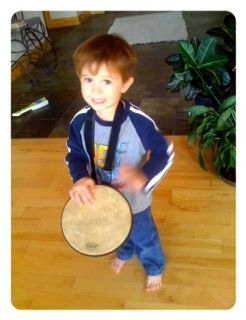Play
3 Musical Ways to Influence a Child's Emotions
New research helps explain why music works on kid's emotions, too
Posted October 22, 2015

When people ask me what I do, and I say I’m a music therapist, I generally get one of three responses:
- The Curious Question: “Music therapy…what’s that?”
- The Personal Connection: “You’re a music therapist?! Oh my goodness, my (mom/dad/grandmother/friend/child) had a music therapist and it was fantastic!”
- The Emotional Association: “Oh I love music therapy! Music is MY therapy.”
This last reaction, the emotion association, speaks to one’s personal connection to music, and to how music is used for the self-regulation of emotions. This is, in fact, one of the most common ways music is consumed—to shift one’s emotions and moods (Sloboda, 2010). This connection to music-induced emotion regulation is largely formed during the formative adolescent and early adult years, and is closely associated with the development of one’s identity and the influence of peer groups.
Stated differently, most people’s favorite songs and artists are those they listened to with their friends in high school and college. These songs are your musical comfort food.
That said, the influence of music and emotions actually starts much, much earlier. It’s no surprise that children naturally gravitate to music, even as infants. But music can also be used to influence emotions in children, even in early childhood.
In a recent study published in a special issue of Frontier in Human Neuroscience, a colleague and I explored in depth how music can be structured to facilitate emotion-related changes in preschool-aged children. Although you are welcome to explore the study in depth, one of the points we highlighted three reasons WHY music can be an effective way to address emotion-related needs in preschoolers (see the Frontiers article for a complete list of citations):
Reason 1: Music is developmentally appropriate.
Reason 2: There is a well-documented connection between music, emotions, and physiologic arousal, even in infants.
Reason 3: Music is typically used in caregiver-child musical interactions.
How might this help you, then? Here are 3 ideas to get you started, some musical ways you can influence the emotional state of your preschool-aged child:
1) Musical Transitions
Transitions are shifts in the schedule. Kids transition daily sleeping to waking, from home to school, from class to class, from school to activity, from activity to home, from awake back to sleep. There are dozens of transitions during the day. Given the high energy and chaos that can easily accompany transitions, this also means there are dozens of opportunities to create an uber-energetic child. Music can help ease transitions in a couple different ways.
One, play background music to change the environment of the space and create a calmer mood. Choose music without words that has a slower tempo, or beat, a softer loudness level, and a pretty, lyrical sound. Play the music for 5-7 minutes during the transition time.
Two, create short little transition ditties. You can have a wake-up song, a going-to-bed song, a time-to-brush teeth song. Don’t worry about how the song sounds—use the music as a way to play with your child. Are you a musical novice? Try taking a song you know well and changing the words. Imagine this to the tune of “Row, Row, Row Your Boat”:
Brush, brush, brush your teeth / Brush your teeth real well / Brush and brush and brush your teeth. / Don’t your teeth feel swell?
See? Though far from Grammy-worthy, it’s potentially quite effective.
2) Musical Play
Children love to play. They laugh, smile, socialize, and learn through play. A second way to influence a preschooler’s emotions is through musical play.
Musical play can involve exploring sounds. Bang those pots and pans with each other or create rhythms on items founds in the environment. My kids once did this quite effectively with a couple sticks and metal trash cans outside a concert hall at my work. They had an impromptu 10-minute trash can percussion concert (then were immediately directed to wash their hands…).
Musical play can also involve singing together. Sing fun songs, sing silly songs, sing songs your child likes. Have fun with it! You can sing those songs in a silly voice and make your child laugh. Or use a puppet and have the puppet “sing” to your child.
3) Musical Calm
There are times to play…and times to be calm. This may happen when a child is upset and you want to help him or her feel better, or when a child is too energetic and you want him or her to calm down. Music can help with this, especially if it’s you singing.
Why you singing? Because one thing that will help you calm the child down more quickly is the relationship you have with that child. The song you sing may redirect the child’s focus or help lower the child’s physiologic arousal, but it’s ultimately the connection between the two of you that will bring on the calm feeling. The singing in this case serves to remind him or her of that connection, and can expedite the return to a calm state.
Follow me on Twitter @KimberlySMoore for daily updates on the latest research and articles related to music, music therapy, and music and the brain. I invite you also to check out my website, www.MusicTherapyMaven.com, for additional information, resources, and strategies.
References
Sloboda, J. A. (2010). Music in everyday life: The role of emotions. In P. N. Juslin and J. A. Sloboda (Eds.), Handbook of music and emotion: Theory, research, applications (pp. 493-514). Oxford: Oxford University Press.
Sena Moore, K., & Hanson-Abromeit, D. (2015). Theory-guided Therapeutic Function of Music to facilitate emotion regulation development in preschool-aged children. Frontiers in Human Neuroscience, 9, 572. doi: 10.3389/fnhum.2015.00572




